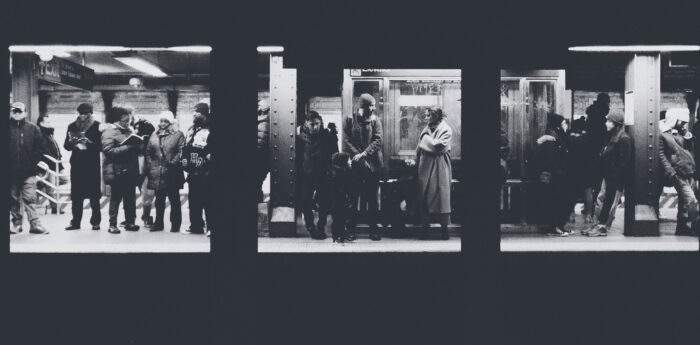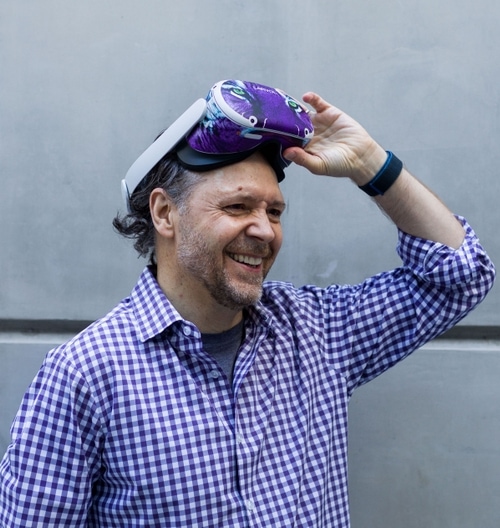
In turn, we use cookies to measure and obtain statistical data about the navigation of the users. You can configure and accept the use of the cookies, and modify your consent options, at any time.

How will work change as the metaverse becomes our new reality? To find answers, futurists Bugge Holm Hansen and Sofie Hvitved venture into the virtual realm to meet with CEO Bruno Larvol, whose firm has been conducting its business in the metaverse for the past six months.
Emerging technologies have always brought convenient alternatives to traditional ways of working. Usually these changes take a while to materialise, but when the pandemic hit, we saw how technological solutions could suddenly become crucial to keeping the workplace running. Extensive investments in future immersive technologies by the world’s largest tech companies hint that we are on the brink of opening new workflows that may be a catalyst for a transition from working on our computers to working inside our computers – and inside the metaverse.
So what is the metaverse, exactly? The answer to that question is that nobody really knows for sure. Some perceive it as a future vision or concept with accompanying business models that have yet to materialise. Others see it as something that is connected to certain technologies like AR, VR, and haptic wearables that enable immersive engagement in virtual spaces. Certainly, immersive social worlds have so far been a central selling point of the metaverse, not least in the vision presented by Meta (formerly Facebook) in their much-discussed concept video from late 2021.
What most anticipations around the metaverse have in common is an emphasis on what it might become. But in many respects, the metaverse (at least in its nascent state) is already here. The groundwork has been laid by the steady merger of our physical and virtual lives which has been happening for some time now. Additionally, immersive technologies are already being used by some first-mover organisations to host meetings, collaborations, and other activities in virtual spaces. The promise these technologies hold for the future is that collaborating, learning and meeting can be made more entertaining when done virtually, and that products, concepts, or scenarios can be tested in immersive environments before making their way into the real world. We may also see co-designing of virtual prototypes or onboarding new employees take place in the metaverse.
Although the potential is there, employees seem to have mixed feelings about a future of where work is done in the immersive metaverse. According to a recent US study by Morning Brew-Harris, 27% of employees are enthusiastic about the potential of adopting AR/VR in the workplace, while 29% are completely unmotivated. Meanwhile, 31% remain hesitant, even though 83% of senior company executives foresee an increase in immersive technology investments.
There are other barriers than employee discontent to overcome as well, not least the cost associated with participating in virtual, immersive experiences. Metaverseenabling tech like haptic wearables, VR headsets, AR glasses, and spatial audio devices have a high price point. Over time, these barriers will diminish as the price of the technology is lowered for consumers, but issues around privacy and security will also need to be addressed. For any organisation wishing to have a presence in the metaverse, it will be essential to be able to secure both their digital assets and their virtual meeting spaces.

Much suggests that metaverse will be more than ‘just’ an immersive experience. It might not only enable us to work in new ways but lead to entirely new forms of work as well. The push towards web3, which includes the emergence of new forms of ownership with blockchain, and distributed token-based economies like that of NFTs, along with the proliferation of decentralised autonomous organisations (DAOs) governed by code rather than people, will also likely factor into future developments of the metaverse. Consequently, we may see the conventional ‘work-to-earn’ approach to making money be supplemented by other ways of participating in the economy, including ‘play-to-earn’ or even ‘participate-to-earn’. In other words, the metaverse may evolve to facilitate systems of labour and employment that are radically different from what we know today, and people may have the option of becoming ‘providers’ in decentralised networks rather than employees in a company.
Time will tell how this will all play out in the future. What we can see already is that some organisations have begun moving their activity into virtual worlds, thus providing a glimpse into future of work in the metaverse. Among them are LARVOL, a company of 150+ employees that provides data and software for the pharmaceutical and healthcare industries.
To learn more about the benefits and struggles associated with working in the metaverse, we met with LARVOL’s founder, Bruno Larvol, who has been running the company on a “VR-first” basis. What this means is that employees of LARVOL, including himself, have worked inside the metaverse for the last six months. The experience has affirmed his belief that the metaverse will be the go-to place for workplace collaboration and learning in the future. Fittingly, we of course decided that our interview should take place in the metaverse as well.
“I’m driving my family crazy, driving my employees crazy and even some of our
customers crazy,” Bruno Larvol tells us. So, why did he do it?

“Initially we wanted to use virtual reality to try to understand and visualise cancer data in order to navigate inside the data, essentially building the Google maps of cancer. This is not an easy thing to do, so it is a long term goal for us.” While working on making that aspiration a reality, Bruno Larvol realised that his company had never had a shared office space because work is done remotely. They were therefore missing out on the value that comes from spending time together rooted in a place.
“A zoom call is never a real place, but to me the metaverse is. Shared memories need a physical location, and presence requires a sense of feeling close spatially. So, I decided we should be the first company to be completely built on the metaverse”, he explains.
“For the last 168 days, all my meetings have taken place in the metaverse. I bought headsets for everyone in the management team, so all our meetings are in virtual reality, avatar to avatar. No phone calls, no Zoom videos, no emails, and no business made in person”, he says.
“My assistant checks my emails in case there’s anything important, but I never check them anymore. I said, well if you want to talk with me, you’ve got to come to the metaverse. I’m sure I’m irritating some people by being ‘Mr Extreme Metaverse’,
but that’s part of the experiment that I’m doing.”
Bruno Larvol’s enthusiasm for the potential of the metaverse for defining the future of work hasn’t lessened because of the experiment. In fact, he believes that in a few short years all of us are going to enter into the metaverse, and that it will be the place where we spend most of our time during work days.
“To me the metaverse is unstoppable. It is not just Second Life, which was the first serious attempt at creating something like it. If Second Life was like the BlackBerry, then this is the iPhone. And soon the technology is going to be truly wearable. Right now, it’s not comfortable to spend more than an hour or two in the metaverse, but with Quest3 and Apple AR, and Samsung joining in as well, things are going to change”, he explains.
It genuinely does feel different meeting in VR rather than having a chat over a zoom call. For one, there is a sense of presence that can’t be replicated by 2D video conferencing. This, precisely, is one of the promises of the metaverse: people together in the same space, even though they are working apart, and gaining all the benefits connected with being present in a room together – even if that room is a virtual one. The question of course is whether this is for everyone. Should more organisations dive into the metaverse, and how?
For the time being, embracing the metaverse means taking a gamble on its longterm
potential. In spite of the rapid improvements in supporting technologies, it will take time to unfold and find its form. Throughout this process, we must remember to remain conscious of the need to create a metaverse fit for the future we desire. For technology to help people, it needs to put them first. If this transition is successful, the metaverse can be a potential gamechanger for all industries, creating new business models reshaping the way we work.